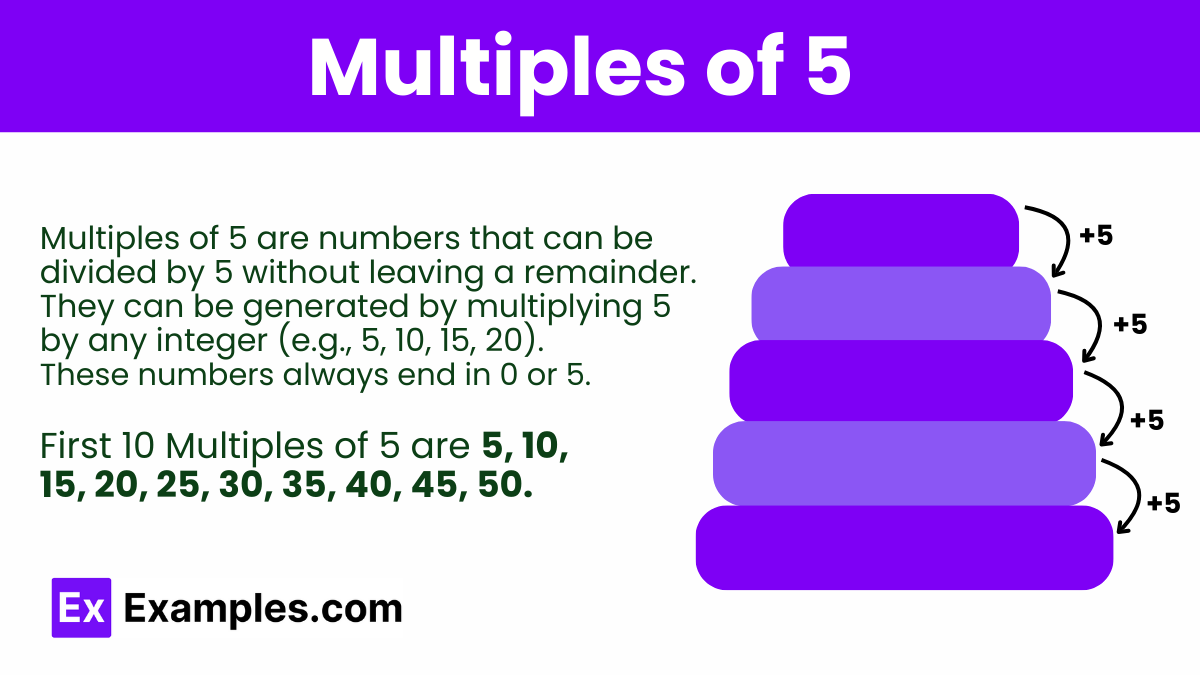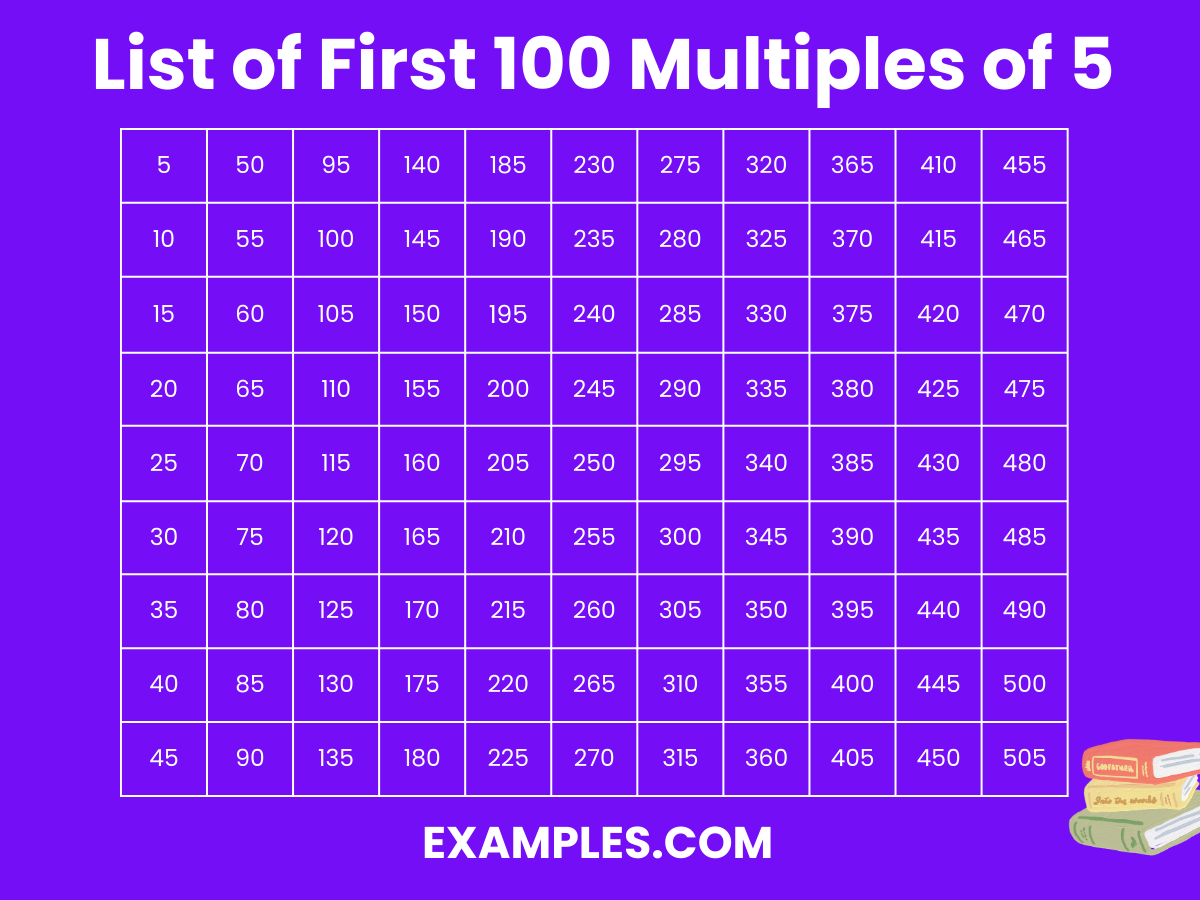Which of the following numbers is a multiple of 5?
12
20
27
33


Multiples of 5 are numbers that result from multiplying 5 by any integer. In mathematics, these numbers, such as 5, 10, 15, and 20, are produced through the multiplication process involving 5. Understanding factors and divisors is crucial, as a multiple of 5 can be evenly divided by 5 without a remainder. Identifying multiples is essential for solving various mathematical problems, including those involving common multiples and divisibility rules.
Multiples of 5 are numbers that can be expressed as 5 times an integer. They form a sequence where each term increases by 5, starting from 0. Examples include 0, 5, 10, 15, 20, and so on.
| Number | Reason | Remainder |
|---|---|---|
| 10 | 10 = 5 × 2 | 0 |
| 25 | 25 = 5 × 5 | 0 |
| 50 | 50 = 5 × 10 | 0 |
| 18 | 18 is not a multiple of 5 (5 does not divide 18 evenly) | 3 |

| Number | Reason | Remainder |
|---|---|---|
| 5 | 5 = 5 × 1 | 0 |
| 10 | 10 = 5 × 2 | 0 |
| 15 | 15 = 5 × 3 | 0 |
| 20 | 20 = 5 × 4 | 0 |
| 25 | 25 = 5 × 5 | 0 |
| 30 | 30 = 5 × 6 | 0 |
| 35 | 35 = 5 × 7 | 0 |
| 40 | 40 = 5 × 8 | 0 |
| 45 | 45 = 5 × 9 | 0 |
| 50 | 50 = 5 × 10 | 0 |
| 55 | 55 = 5 × 11 | 0 |
| 60 | 60 = 5 × 12 | 0 |
| 65 | 65 = 5 × 13 | 0 |
| 70 | 70 = 5 × 14 | 0 |
| 75 | 75 = 5 × 15 | 0 |
| 80 | 80 = 5 × 16 | 0 |
| 85 | 85 = 5 × 17 | 0 |
| 90 | 90 = 5 × 18 | 0 |
| 95 | 95 = 5 × 19 | 0 |
| 100 | 100 = 5 × 20 | 0 |
| 105 | 105 = 5 × 21 | 0 |
| 110 | 110 = 5 × 22 | 0 |
| 115 | 115 = 5 × 23 | 0 |
| 120 | 120 = 5 × 24 | 0 |
| 125 | 125 = 5 × 25 | 0 |
| 130 | 130 = 5 × 26 | 0 |
| 135 | 135 = 5 × 27 | 0 |
| 140 | 140 = 5 × 28 | 0 |
| 145 | 145 = 5 × 29 | 0 |
| 150 | 150 = 5 × 30 | 0 |
| 155 | 155 = 5 × 31 | 0 |
| 160 | 160 = 5 × 32 | 0 |
| 165 | 165 = 5 × 33 | 0 |
| 170 | 170 = 5 × 34 | 0 |
| 175 | 175 = 5 × 35 | 0 |
| 180 | 180 = 5 × 36 | 0 |
| 185 | 185 = 5 × 37 | 0 |
| 190 | 190 = 5 × 38 | 0 |
| 195 | 195 = 5 × 39 | 0 |
| 200 | 200 = 5 × 40 | 0 |
| 205 | 205 = 5 × 41 | 0 |
| 210 | 210 = 5 × 42 | 0 |
| 215 | 215 = 5 × 43 | 0 |
| 220 | 220 = 5 × 44 | 0 |
| 225 | 225 = 5 × 45 | 0 |
| 230 | 230 = 5 × 46 | 0 |
| 235 | 235 = 5 × 47 | 0 |
| 240 | 240 = 5 × 48 | 0 |
| 245 | 245 = 5 × 49 | 0 |
| 250 | 250 = 5 × 50 | 0 |
| 255 | 255 = 5 × 51 | 0 |
| 260 | 260 = 5 × 52 | 0 |
| 265 | 265 = 5 × 53 | 0 |
| 270 | 270 = 5 × 54 | 0 |
| 275 | 275 = 5 × 55 | 0 |
| 280 | 280 = 5 × 56 | 0 |
| 285 | 285 = 5 × 57 | 0 |
| 290 | 290 = 5 × 58 | 0 |
| 295 | 295 = 5 × 59 | 0 |
| 300 | 300 = 5 × 60 | 0 |
| 305 | 305 = 5 × 61 | 0 |
| 310 | 310 = 5 × 62 | 0 |
| 315 | 315 = 5 × 63 | 0 |
| 320 | 320 = 5 × 64 | 0 |
| 325 | 325 = 5 × 65 | 0 |
| 330 | 330 = 5 × 66 | 0 |
| 335 | 335 = 5 × 67 | 0 |
| 340 | 340 = 5 × 68 | 0 |
| 345 | 345 = 5 × 69 | 0 |
| 350 | 350 = 5 × 70 | 0 |
| 355 | 355 = 5 × 71 | 0 |
| 360 | 360 = 5 × 72 | 0 |
| 365 | 365 = 5 × 73 | 0 |
| 370 | 370 = 5 × 74 | 0 |
| 375 | 375 = 5 × 75 | 0 |
| 380 | 380 = 5 × 76 | 0 |
| 385 | 385 = 5 × 77 | 0 |
| 390 | 390 = 5 × 78 | 0 |
| 395 | 395 = 5 × 79 | 0 |
| 400 | 400 = 5 × 80 | 0 |
| 405 | 405 = 5 × 81 | 0 |
| 410 | 410 = 5 × 82 | 0 |
| 415 | 415 = 5 × 83 | 0 |
| 420 | 420 = 5 × 84 | 0 |
| 425 | 425 = 5 × 85 | 0 |
| 430 | 430 = 5 × 86 | 0 |
| 435 | 435 = 5 × 87 | 0 |
| 440 | 440 = 5 × 88 | 0 |
| 445 | 445 = 5 × 89 | 0 |
| 450 | 450 = 5 × 90 | 0 |
| 455 | 455 = 5 × 91 | 0 |
| 460 | 460 = 5 × 92 | 0 |
| 465 | 465 = 5 × 93 | 0 |
| 470 | 470 = 5 × 94 | 0 |
| 475 | 475 = 5 × 95 | 0 |
| 480 | 480 = 5 × 96 | 0 |
| 485 | 485 = 5 × 97 | 0 |
| 490 | 490 = 5 × 98 | 0 |
| 495 | 495 = 5 × 99 | 0 |
| 500 | 500 = 5 × 100 | 0 |
Multiples of 5 are numbers that can be divided by 5 without leaving a remainder. They form an arithmetic sequence where each term is 5 more than the previous term. Here are some examples:
5, 10, 15, 20, 25, 30, 35, 40, 45, 50.
55, 60, 65, 70, 75, 80, 85, 90, 95, 100.
Clocks and Schedules: A standard clock is divided into 60 minutes, with each number representing 5-minute intervals. Typical work or school schedules are often broken into 5-minute increments, making it easy to calculate durations and intervals.
Currency and Prices: In many countries, the smallest denomination often leads to prices ending in multiples of 5 or 10. For example, items priced at $1.95, $2.50, $3.75. Interest rates and tax calculations frequently use multiples of 5% for simplicity and ease of understanding.
Weight and Volume: Standard measurements in recipes or construction often use multiples of 5. For instance, a recipe might call for 5 grams of salt or 250 milliliters of water.
Points and Scoring: Various sports use multiples of 5 for scoring. For example, in American football, a touchdown is worth 6 points, but with the extra point, it becomes 7, and a field goal is worth 3 points, both aligning closely with multiples of 5 for game calculations.
Packaging and Bulk Buying: Many products are packaged or sold in quantities that are multiples of 5, such as packs of 10 pens or boxes of 20 bottles.
Imagine you are organizing a party and need to calculate the total number of items in packs:
You are budgeting for a week and decide to allocate your money in multiples of 5:
Multiples of 5 are numbers that can be expressed as 5 times an integer. They include numbers like 5, 10, 15, 20, and so on.
A number is a multiple of 5 if it ends in 0 or 5. For example, 25 and 30 are multiples of 5, whereas 22 and 33 are not.
The smallest positive multiple of 5 is 5 itself.
No, not all multiples of 5 are multiples of 10. While all multiples of 10 are multiples of 5, multiples of 5 that end in 5 (like 15, 25, etc.) are not multiples of 10.
The greatest common factor of two multiples of 5 is always at least 5. For example, the GCF of 15 and 25 is 5.
Yes, negative numbers can be multiples of 5. Examples include -5, -10, -15, and so on.
Multiples of 5 are commonly used in timekeeping (minutes), currency (nickels, dimes), and measurement units (feet, inches).
The sum of the first 10 multiples of 5 (5, 10, 15, 20, 25, 30, 35, 40, 45, and 50) is 275.
Yes, multiples of 5 increase linearly, with a common difference of 5 between consecutive terms (e.g., 5, 10, 15, 20, etc.).
The least common multiple of two multiples of 5 is the smallest number that is a multiple of both. For instance, the LCM of 10 and 15 is 30.
Text prompt
Add Tone
10 Examples of Public speaking
20 Examples of Gas lighting
Which of the following numbers is a multiple of 5?
12
20
27
33
What is the next multiple of 5 after 45?
46
48
50
55
Which number is not a multiple of 5?
55
60
63
70
What is the smallest multiple of 5 greater than 70?
72
73
75
78
Which of the following numbers is a multiple of 5?
80
83
88
92
What is the next multiple of 5 after 95?
96
98
100
105
Which number is not a multiple of 5?
105
110
113
115
What is the largest multiple of 5 less than 150?
140
145
148
150
Which of the following numbers is a multiple of 5?
159
160
162
164
What is the next multiple of 5 after 170?
171
172
175
178
Before you leave, take our quick quiz to enhance your learning!

